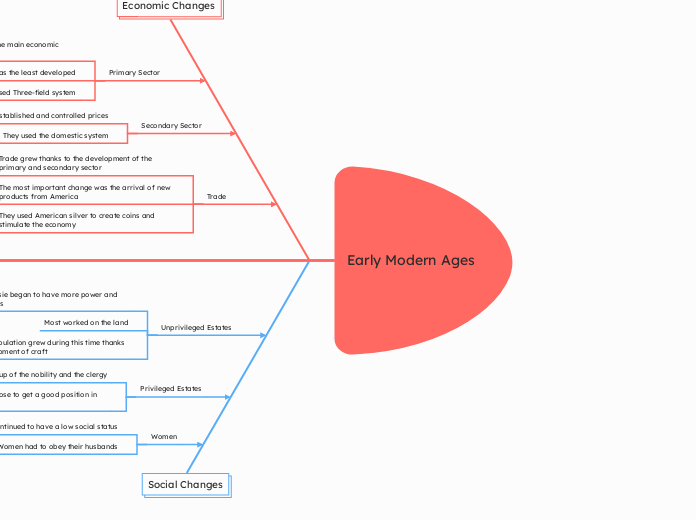Early Modern Ages
Economic Changes
Primary Sector
Agriculture continued to be the main economic activity
The primary sector was the least developed
They used Three-field system
Secondary Sector
Artisan guilds established and controlled prices
They used the domestic system
Trade
Trade grew thanks to the development of the primary and secondary sector
The most important change was the arrival of new products from America
They used American silver to create coins and stimulate the economy
Political Changes
Collect more taxes due to the increase in agriculture and craft production
His goal was to gain more power at the expense of the nobles
In the authoritarian monarchy, the nobles had to obey the monarch
The following institutions allowed the monarch to have more strength:
Royal Government
Royal Army
Diplomatic Corps
This new political organization was called the modern state.
Historic Events
The discovery of America
In 1492 the Spanish discovered America and conquered it.
The invention of the printing press
In the year 1440, the printing press was invented by Johannes Gutenberg.
Social Changes
Unprivileged Estates
The bourgeoisie began to have more power and the nobles less
Most worked on the land
The urban population grew during this time thanks to the development of craft
Privileged Estates
It was made up of the nobility and the clergy
Only they could choose to get a good position in politics
Women
The woman continued to have a low social status
Women had to obey their husbands
Cultural Changes
Interest in Classical Culture
Greek and Roman culture became the reference point
Anthropocentrism
Humans were the center of philosophical reflection and artistic creation
Optimism and Creativity
They believed in a better life and their creativity resulted in many inventions
The Desire For Knowledge
Humanists are not satisfied with knowing about a single area. I wanted to know everything
Critical Thinking
People began to question thoughts and tried to explain natural phenomena
